“Eyes on Iran:” A Poignant Artistic Statement for Women’s Rights from New York

On a sunny but wind-blistering November morning journalists gathered in FDR Four Freedoms State Park on Randall’s Island in New York City to celebrate the unveiling of seven public artworks installed in the park and multiple activations in New York City and Miami. “Eyes on Iran,” an initiative featuring Iranian and other artists with works advocating for the ongoing revolution, or the term that organizers used: Women’s Revolution, in Iran. We were a relatively intimate group, around fifty. However, this event and its subsequent activations would reverberate the globe, publicized across major media channels. The project situates art as an important tool for advocacy to shape better futures while centering humility and humanity in the face of Iran’s tumultuous events to publics beyond its borders.

Drawing much applause the opening event featured impassioned pleas from former U.S. Secretary of State Hillary Rodham Clinton, Human Rights Lawyer and director of the Strategic Litigation Project at the Atlantic Council Gissou Nia, human rights activist Nazanin Afshin-Jam Mackay, artists Sheida Soleimani and Shirin Neshat, and actor and singer Sepideh Moafi. Their request was for us to continue to hold the ruthless government of the Islamic Republic of Iran accountable for the lethal violence against protestors and repression of the rights of women and girls.

Upon entering the park, a mural by Soleimani of a hand holding a white burning hijab against the backdrop of a CT scan powerfully centers the struggle of Iranian women to incoming visitors. On September 16, 2022, Jina Mahsa Amini, a twenty-two-year-old Kurdish woman, died in police custody. The official cause of death was cited as cardiac arrest. However, a leaked CT scan revealed multiple skull fractures caused by head trauma as a result of the police beating was more plausible. The artist’s choice of white for the hijab nods to #whitewednedays; a campaign started in 2017 where women wear white on Wednesdays io protest the compulsoriness of the headscarf. Emboldened by the tragedy of Amini’s fate women now burn their hijabs in public—enough is enough.
Amini was taken into custody in Tehran for wearing her hijab incorrectly—some strands of her hair had been visible. Women are often harassed by the country’s so called morality police. Since Amini’s murder, thousands of people across ethnic lines have protested in over 155 cities in Iran, chanting the Kurdish slogan jin, jiyan, azadî—Woman, Life, Freedom. “What we are seeing is a revolution led by young women who are just not willing to live with the loss of freedom being imposed upon them,” said Clinton.
Incorporating the plight of Iranian and the countries minority Kurdish women into a larger global context, Clinton continued: “Their fight is our fight this is about the global struggle for human rights, human dignity, human freedom, gender equality, and justice…Women demanding action must be supported by all of us.” It was the first time I had heard Clinton speak in person and I was moved by her resilience and fortitude. I had campaigned for her in 2016. Seeing Clinton support Iranian women within this context, choosing to back “Eyes on Iran” validated the importance of art as a powerful form of advocacy.
Clinton is a staunch supporter of women’s rights, she famously said “human rights are women’s rights and women’s rights are human rights” at a conference in Beijing in 1995. An echo of the abolitionist and proto-feminists of the 1830s. This continued lineage of activism, advocating for the rights of women and children at once angers–why is it still necessary?—but it is an anger that has inspired action. Those protesting in Iran are risking their lives to stand up for the equal rights of women.

The works are all multilayered. A testimony to those who have been executed, artist Z lists some of their names in the piece “Baraye You.” Commemorating the bravery of their sacrifice “Baraye” is the title of a song by Shervin Hajipour written for for this revolution. While Sepideh Mehraban’s “Thread of Stories” uses Persian rugs—at once deeply personal artifacts of the domestic interior but also exquisitely crafted objects that serve as a source of pride for the country—as a canvas. Her “carpets” convey the complexity of history, often highlighting stains that cannot be removed.
In opposition to Soleimani’s mural, in closing, a work titled “Bricks of a revolution” consists of 650 bricks laid out in orderly fashion, each engraved with the name of a person arrested during the recent protests. This number is only a small fraction of those who have been imprisoned thus far; in November, Reuters estimated the number to be 15,000. Hailing from Tabriz in Iran the street artist duo, brothers Saman Oskouei and Sasan Oskouei—known as Icy and Sot—moved to New York in 2006. Their work often engages with people whose rights are marginalized, uncovering the ill-treatment of migrants in Europe and on the Mexico and US border for instance. Artists in Iran have long been subject to censorship, harassment, imprisonment, or death if they attempt to challenge the government. Icy and Sot’s piece would not be permitted in Iran.
Participating artists in New York were Iranians Sheida Soleimani, Aphrodite Deìsireìe Navab, Z, Icy and Sot, Shirin Neshat, Mahvash Mostala, Sepideh Mehraban, and Shirin Towfiq, alongside the American artist Hank Willis Thomas, a well-known social justice activist, and French artist JR.
Every detail of the project has been amplified to serve its purpose; there is even a narrative to be garnered from its location. Accessible by subway, or, the tram—which is far more pleasant with views over Manhattan’s skyline on one side and water views on the other—Roosevelt island is a small island located off the East bank of Manhattan, in the East River. The population of the island is just shy of 12,000. The park is a public memorial to former U.S. President Franklin D. Roosevelt, whose term lasted from 1933 to 1945. Tying into “Eyes on Iran”’s important message of anti-repression, the park takes its name from Roosevelt’s 1941 State of the Union Address where he articulated his universal world vision for the freedom of speech and of religion, and freedom from want and fear, commonly known as the “Four Freedoms” speech. These freedoms are currently under attack in Iran.

Most relevant however is what the park overlooks, and where you can see it from; it is separated from the United Nation’s towering headquarters, only by a slim body of water. “In the shadow of the UN,” as Clinton remarked during her opening speech. Neshat’s piece “Offered Eyes” from 1993 has its eye on the building itself.
The work is a revives her breakthrough series “Women of Allah,” a deeply personal reflection of the changes in Iran after the Islamic Revolution. Neshat was sent to study in California in 1975, at the age of 17. Some years later, in 1979, the Shah of Iran was overthrown by rebels led by Ayatollah Khomeini who steered the country in a religiously conservative direction. In 1991, when Neshat returned to Iran for her first visit since her move to the U.S she found that behaviours and public life had changed drastically. “Offered Eyes” was part of a collection of black-and-white photographs reflecting these changes, The critically acclaimed photographs feature veiled and sometimes gun-bearing women to represent women’s involvement in the Iran-Iraq War and Islamic Revolution. Neshat used handwritten versus from feminist poets that she superimposed on body parts to represent desires, repressed and lived. “Offered Eyes” is a photograph of the artist’s own right eye, a line in Farsi calligraphy from “Pity the Garden” a poem by Furugh Farrukhzad snakes around its iris. Farrukhzad’s work, often unbridled and sexual in nature, stands at odds with the conservative religious values of the country. With the work Neshat conveys that she see what the government attempts to suppress. In the park the iconic photograph is installed across a stone wall that runs along the waterfront and can be seen from within the U.N. headquarters across the water.
Further engaging with the concept of sight, flying billboards carry artworks depicting eyes by Thomas and Mostala, who left Iran during the Iran-Iraq War, over Miami. These planes flew a couple of days after the unveiling on Roosevelt Island, coinciding with the major art fair Art Basel Miami Beach, and days later over New York City.
The date chosen to unveil the project, November 28, also had conceptual resonance. On the same date in 1943 a new vision for Iran was cemented as Allied leaders Franklin D. Roosevelt, Winston Churchill, and Joseph Stalin met in Tehran to coordinate the maintenance of the independence and territorial integrity of Iran. Now protests are calling for a new vision for Iran that sees women.
On the wider role of the show, artist Neshat remarked “many artists throughout the diaspora and beyond are bringing our vision to bear to ensure international audiences and institutions remain aware of what is happening in Iran, in their eyes and in their hearts, and feel moved to respond.” As it is difficult to discern the credibility of news coming from Iran—official news is often propaganda—art which is connected to feeling rather than accuracy of fact serves as an important vehicle to sustain global interest in the uprising.
The creative class has been important in activating supporters in Iran. Many actors and musicians have publicly opposed the law that requires women to wear headscarves—several of them have been detained and others also executed. Requiring little data to operate, Twitter has become an important source for mobilization and updates as the government continues to cut off internet access as an attempt to assuage protests.
“The world’s eyes have been focused on the courage of Iranian citizens in their quest for freedom, in the face of increasingly grave danger,” said human rights activist Nazanin Afshin-Jam Mackay. “The Islamic Republic has censored them and attempted to blind the world to the potential of this movement. ‘Eyes on Iran’ is our response to their call for a free Iran.”
Advocacy and revolution take the courage and work of many. “Eyes on Iran” is a partnership between artist collective For Freedoms and Vital Voices Global Partnership, a non-profit elevating women leaders, to support the Woman, Life, Freedom campaign—titled after the slogan of the revolution—demanding the removal of Iran from the U.N.’s leading body to promote women’s rights, the Commission on the Status of Women.
Taking place amidst the U.N. Initiative 16 Days of Activism Against Gender-Based Violence “Eyes on Iran” was timed to proceed a vote on whether or not to remove Iran from the Commission on the Status of Women for the remainder of its four year term. “The fact that Iran is a member is a bitter irony,” continued Clinton during her speech at Four Freedoms Park. On December 14 a majority of twenty-nine countries voted in favor to remove Iran from the council. Certainly, the vote was not determined solely by “Eyes on Iran,” but rather, by advocacy and lobbying of many organizations some of which use art as a messaging tool, or a way to pull on the heartstrings.
 Aphrodite Désirée Navab. “Uproot the Roots, Rise up: Woman/Zan/زن.,”
Aphrodite Désirée Navab. “Uproot the Roots, Rise up: Woman/Zan/زن.,”
- Photo by Austin Paz, Courtesy For Freedoms.
One of the more poetic works in the park is Navab’s “Uproot the Roots, Rise up: Woman/Zan/زن” installed around trees on either side of the park’s walkway. The work consists of protest bandanas tied at eye level in the colors of the Iranian flag—green, white, and red. Instead of the symbol of the current flag of the Islamic Republic or the previous flag of the Shah at its center, the bandanas don the Farsi word for woman زن, a powerful call for regeneration.
The people of Iran and its diaspora have struggled through several protests and uprisings against its current government, notably the 1999 student protests against the closure of the reformist newspaper “Salam” and in 2009 protests against election fraud. Activists, including Neshat, held a three-day hungerstrike outside of the U.N. then to garner attention for it. Several protests have been economically motivated, the larges in 2019 were protests over an overnight hike in fuel prices that led Iranian authorities to kill 1,500 protesters. The current protests are the first to unite all Iranians—including Kurds, Turks, Baloch, and women and men—to focus squarely on the rights of women while mobilizing art and the cultural sphere to catch the world’s attention.
In her speech Clinton said, “think of the women in Afghanistan deprived of education, the women in Ukraine defending their country against the barbarity of Putin’s invasion, the women here in the United States fighting for our bodily autonomy.” She continued, “We all struggle and we all have a right to be free and equal.” It is our time to support Iran and we can do so by continuing to raise awareness by engaging with the art created in response to and in support of the movement.
You Might Also Like
What's Your Reaction?
Anna Mikaela Ekstrand is editor-in-chief and founder of Cultbytes. She mediates art through writing, curating, and lecturing. Her latest books are Assuming Asymmetries: Conversations on Curating Public Art Projects of the 1980s and 1990s and Curating Beyond the Mainstream. Send your inquiries, tips, and pitches to info@cultbytes.com.

